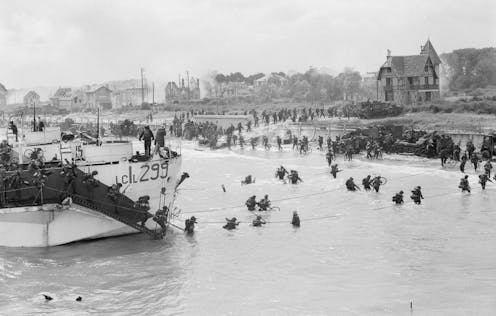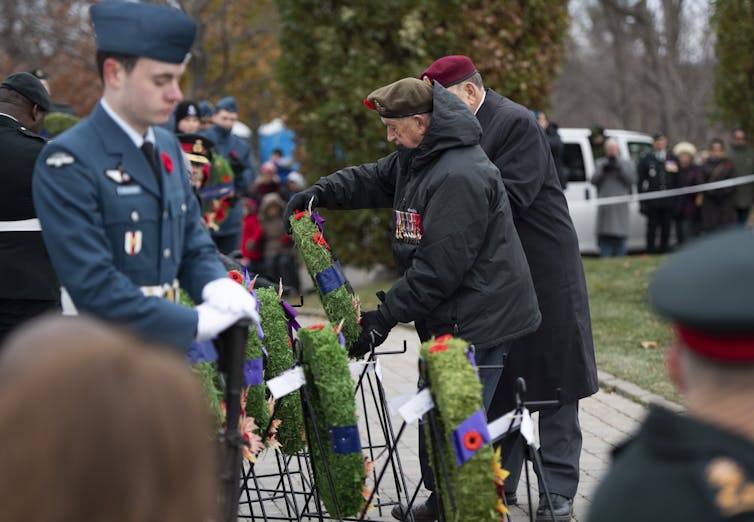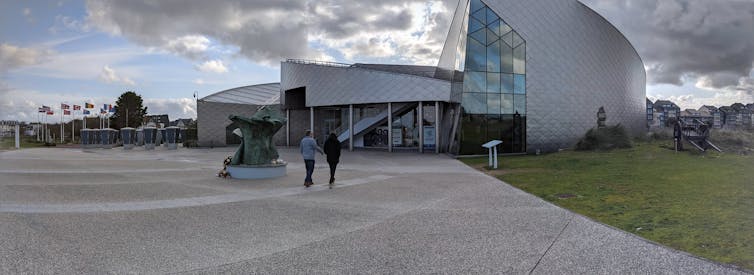
Villages and towns along the Normandy coast will fill with visitors this week to commemorate the 78th anniversary of the D-Day landings on June 6. Flags will fly to welcome and acknowledge those who fought in the Great Crusade. Over the summer, hundreds of commemorations will take place to mark 80 days of battle.
While not the only contribution by Canadian service men and women, D-Day takes a prominent place in Canada’s cultural memory of the Second World War.
As a researcher of war heritage, I have observed and participated in commemorations in Normandy over the years. My focus has been on how the region, as a memorialized landscape of war, is managed and interpreted. I am also interested in the meaning people draw from the histories and stories told at these sites of memory.
My research has been augmented by my time as a guide at Vimy Ridge, by serving in the navy and by producing films as part of the War Heritage Research Initiative at Royal Roads University.
This year’s anniversary offers a moment to consider how Canadians use commemoration as an act of community and a reflection of national identity. We are undergoing a turn in the evolution of war remembrance.
The politics of remembrance
The politics of remembrance refers to the many voices engaged in how war and the fallen should be memorialized and remembered — from the challenges and opportunities associated with memorial design, speeches by heads of state and war art, to the interpretation of a war heritage site.
Politics of remembrance evolve with new interpretations of the past to suit present-day ideological needs. While expected, the politics of remembrance illustrate how the past can unify or divide people in the present. And the forces at play seem to be changing — three issues point to a new politics of remembrance.
1. The passing of veterans: There is the inevitable passing of Second World War veterans. With less than 20,000 veterans remaining, in their passing we lose the voice of witnesses.
New generations will become entirely reliant on learning about the Second World War through various secondary means, like museums, schools, local commemorations and books and films. More funding to support communities to remember and commemorate is important.

2. Canadian war heritage overseas under threat: In the early 2000s, the Juno Beach Centre was established in Normandy, but it is currently under threat due to condo development. The centre’s mandate was ambitious — to not only teach about what happened in Normandy and Canada’s wartime involvement, but of Canada as a nation.
Veterans realized the importance of a commemorative hub in Europe for Canada’s Second World War story. That vision, and the centre itself, warrants a national effort to protect and preserve this cornerstone of Canadian heritage overseas.
3. Contest to own war memory: There is an evolving political contest to own war memory, and with it, to take the high ground of Canadian identity. Earlier this year, Erin O’Toole claimed to lead the party of “Robert Borden and Vimy Ridge.” And there was public outcry over the desecration of the National Memorial by the so-called “freedom convoy” and the efforts to “reclaim” it.
Similar to the co-opting of the Canadian flag, Canada’s war memory has become a source of inspiration and misinterpretation to justify opinions concerning the nature of freedom and what it means to be Canadian. The consequences are divisive and diminish the memory and sacrifices of Canadians.
A moral obligation to remember
Inherent in the politics of remembrance is the belief among many that there is a moral obligation to remember.
The meaning of remembrance is open to interpretation because each person’s experience with and connections to war, military and civilian, are different.

Remembrance for the post-veteran generations involves learning about history and trying to comprehend the what, how and why remembering is relevant today. Visiting sites of war memory, such as Normandy, assist in gaining new perspectives while acknowledging that remembrance is also a journey to imagine the past and its context.
Standing in the footsteps of soldiers triggers many reflections, including on the violence of war, responsibility, camaraderie, sacrifice, liberation and freedom. People often think about what they would do, as hard as it is to imagine. Commemorating with other nationalities is important in Normandy, especially with those who were liberated, and serves to reconcile the past with former enemies.
While nationalism brews with ease in remembrance, there are many sites of war memory stripped of worldviews, leaving only the universally shared sense of loss and death, and the call for humanity and peace.
I think of places like Place des 37 Canadiens in Authie, Normandy, where soldiers who had surrendered were executed. These histories are profound and gut-wrenching. But spending time there allows the visitor to break free of the myth of the war experience.
Remembrance as a force to heal, reconcile and unify, is something that should also be done here at home.
Geoffrey Bird does not work for, consult, own shares in or receive funding from any company or organisation that would benefit from this article, and has disclosed no relevant affiliations beyond their academic appointment.
This article was originally published on The Conversation. Read the original article.







